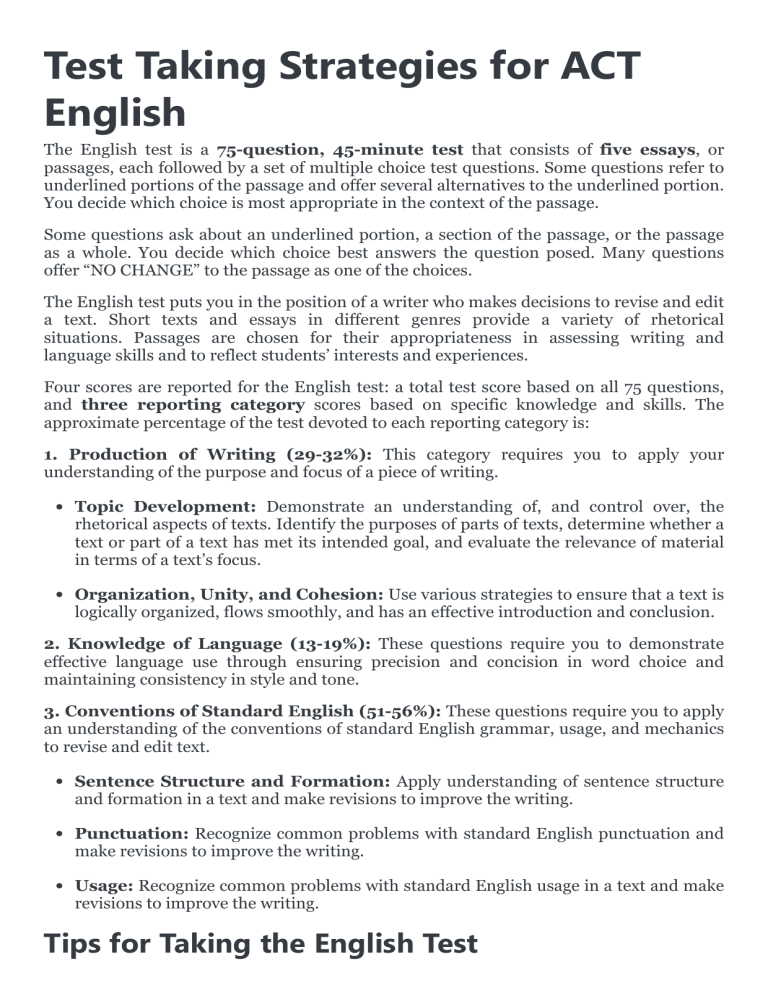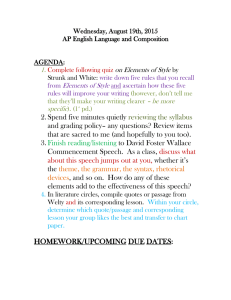
Test Taking Strategies for ACT English The English test is a 75-question, 45-minute test that consists of five essays, or passages, each followed by a set of multiple choice test questions. Some questions refer to underlined portions of the passage and offer several alternatives to the underlined portion. You decide which choice is most appropriate in the context of the passage. Some questions ask about an underlined portion, a section of the passage, or the passage as a whole. You decide which choice best answers the question posed. Many questions offer “NO CHANGE” to the passage as one of the choices. The English test puts you in the position of a writer who makes decisions to revise and edit a text. Short texts and essays in different genres provide a variety of rhetorical situations. Passages are chosen for their appropriateness in assessing writing and language skills and to reflect students’ interests and experiences. Four scores are reported for the English test: a total test score based on all 75 questions, and three reporting category scores based on specific knowledge and skills. The approximate percentage of the test devoted to each reporting category is: 1. Production of Writing (29-32%): This category requires you to apply your understanding of the purpose and focus of a piece of writing. Topic Development: Demonstrate an understanding of, and control over, the rhetorical aspects of texts. Identify the purposes of parts of texts, determine whether a text or part of a text has met its intended goal, and evaluate the relevance of material in terms of a text’s focus. Organization, Unity, and Cohesion: Use various strategies to ensure that a text is logically organized, flows smoothly, and has an effective introduction and conclusion. 2. Knowledge of Language (13-19%): These questions require you to demonstrate effective language use through ensuring precision and concision in word choice and maintaining consistency in style and tone. 3. Conventions of Standard English (51-56%): These questions require you to apply an understanding of the conventions of standard English grammar, usage, and mechanics to revise and edit text. Sentence Structure and Formation: Apply understanding of sentence structure and formation in a text and make revisions to improve the writing. Punctuation: Recognize common problems with standard English punctuation and make revisions to improve the writing. Usage: Recognize common problems with standard English usage in a text and make revisions to improve the writing. Tips for Taking the English Test 1. Be aware of the writing style used in each passage The five passages cover a variety of topics and are written in a variety of styles. It is important that you take into account the writing style used in each passage. When responding to a question, be sure to understand the context of the question. Consider how the sentence containing an underlined portion fits in with the surrounding sentences and into the passage as a whole. 2. Examine the underlined portions of the passage Before responding to a question with an underlined portion, carefully examine what is underlined in the text. Consider the elements of writing included in each underlined portion. Some questions will ask you to base your decision on some specific element of writing, such as the tone or emphasis the text should convey. Some questions will ask you to choose the alternative to the underlined portion that is NOT or LEAST acceptable. The answer choices for each question will contain changes in one or more of those elements of writing. 3. Be aware of questions with no underlined portions You will be asked some questions about a section of the passage or about the passage as a whole, in light of a given rhetorical situation. Questions of this type are often identified by a question number in a box located at the appropriate point in the passage. Questions about the entire passage are placed at the end of the passage and introduced by a horizontal box enclosing the following instruction: “Questions __ and __ ask about the preceding passage as a whole.” 4. Note the differences in the answer choices Many of the questions in the test will involve more than one aspect of writing. Examine each answer choice and how it differs from the others. Be careful not to choose an answer that corrects one error but causes a different error. 5. Determine the best answer When a question asks you to choose the best alternative to an underlined portion, consider the following approach: Decide how the underlined portion might best be phrased in standard written English or in terms of the particular question posed. ~ If the underlined portion is the best answer, select “NO CHANGE.” If not, check to see whether your phrasing is one of the other answer choices. If you do not find your phrasing, choose the best of the answers presented. For questions cued by a number in a box, decide which choice is most appropriate in terms of the question posed or the stated rhetorical situation. 6. Reread the sentence, using your selected answer Once you have selected the answer you feel is best, reread the corresponding sentence of the passage, inserting your selected answer at the appropriate place in the text to make sure it is the best answer within the context of the passage. ACT Resource Links ACT Online Practice Tests: https://www.crackab.com/act/ ❖ ACT English Practice Tests: https://www.crackab.com/act/english/ ❖ ACT Math Practice Tests: https://www.crackab.com/act/math/ ❖ ACT Reading Practice Tests: https://www.crackab.com/act/reading/ ❖ ACT Science Practice Tests: https://www.crackab.com/act/science/ ACT Grammar: https://www.crackab.com/act/grammar/ ACT Real Past Papers Download: https://www.crackab.com/act-downloads/ Mock ACT Tests Online: https://exam.actexam.net Digital SAT Practice Tests: https://www.cracksat.net https://www.satpanda.com Real SAT Tests Download: http://www.cracksat.net/sat-downloads/ More ACT Online Practice Tests: https://www.actpanda.com AP Exams Practice Tests: https://www.crackap.com www.crackab.com






